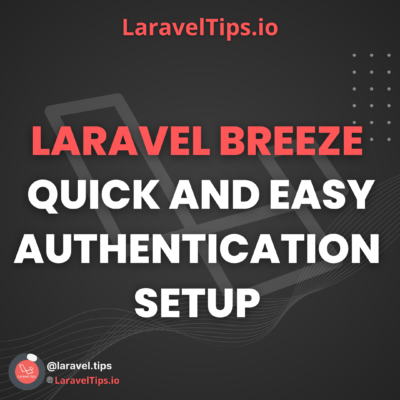Laravel is one of the most popular PHP frameworks used for building web applications. Laravel Breeze is a lightweight package that provides a simple, yet secure authentication system for Laravel applications. In this blog post, we’ll provide a comprehensive guide for beginners to get started with Laravel Breeze.
What is Laravel Breeze?
Laravel Breeze is a lightweight authentication system for Laravel applications. It is built on top of Laravel’s authentication system and provides a simple, yet secure way to authenticate users. It comes with pre-built authentication routes, views, and controllers that you can use to quickly build an authentication system for your application. Laravel Breeze is perfect for building simple applications that require basic authentication functionality.
Some key features of Laravel Breeze include:
- Simple installation and configuration
- Pre-built authentication views and routes
- Customizable authentication workflows
- Support for email verification and password reset
Installing Laravel Breeze
Before you can start using Laravel Breeze, you need to install it in your Laravel application. Here are the steps to install Laravel Breeze using Composer:
Step 1: Install Laravel Before installing Laravel Breeze, you need to have a Laravel application set up. If you don’t have one already, you can create a new Laravel project using the following command:
composer create-project --prefer-dist laravel/laravel myapp
Step 2: Install Laravel Breeze Once you have a Laravel application set up, you can install Laravel Breeze using the following command:
composer require laravel/breeze --dev
Step 3: Install NPM dependencies Laravel Breeze comes with pre-built authentication views that require some additional dependencies. You can install these dependencies using the following command:
npm install && npm run dev
Step 4: Run the migration Finally, you need to run the database migration to create the necessary tables for authentication:
php artisan migrate
Customizing Laravel Breeze
Laravel Breeze comes with pre-built authentication views and routes, but you can customize them to fit your application’s needs. Here are some customization options that you can consider:
Customizing authentication workflows: By default, Laravel Breeze comes with a simple authentication workflow that includes registration, login, and logout. However, you can customize this workflow to include additional steps or to modify the behavior of existing steps. For example, you can add custom fields to the registration form or modify the login and logout behavior.
Adding custom fields to the registration form: If you need to collect additional information from users during registration, you can add custom fields to the registration form. Laravel Breeze makes it easy to do this by providing a registration controller that you can modify to include your custom fields.
Modifying login and logout behavior: Laravel Breeze provides pre-built login and logout routes, but you can customize them to fit your application’s needs. For example, you can redirect users to a specific page after they log in or log out.
Advanced authentication techniques: Laravel Breeze provides a simple authentication system, but you can extend it to support more advanced authentication techniques. For example, you can implement multiple authentication systems within a single application or integrate with other authentication providers.
Common Issues and Debugging Techniques
While Laravel Breeze is a powerful and easy-to-use authentication system, you may encounter some issues while working with it. Here are some common issues that you may encounter while working with Laravel Breeze, along with some debugging techniques:
- Route conflicts: Laravel Breeze comes with pre-built authentication routes, which may conflict with existing routes in your application. To resolve this issue, you can modify the authentication route prefixes in the
AuthServiceProvideror change the existing routes in your application. - View customization: If you need to customize the pre-built authentication views provided by Laravel Breeze, you can publish them to your application and modify them as needed. However, if you modify the views directly in the package, you may encounter issues when updating Laravel or Laravel Breeze in the future.
- Email configuration: Laravel Breeze supports email verification and password reset, but you need to configure your email settings in your application’s
.envfile to use these features. If you’re having issues with email configuration, make sure to double-check your settings and test them with a valid email address. - User registration issues: If you’re having issues with user registration, make sure to check the validation rules in the registration controller and the database migration for the
userstable. You may also need to customize the registration view and controller to fit your application’s needs. - Debugging techniques: To debug issues with Laravel Breeze, you can use Laravel’s built-in debugging tools, such as the
dd()function, logging, and the Laravel Debugbar. You can also check the Laravel and Laravel Breeze documentation and forums for solutions to common issues.
Conclusion:
Laravel Breeze is a powerful and easy-to-use authentication system for Laravel applications. With its pre-built authentication routes, views, and controllers, it provides a simple, yet secure way to authenticate users in your application. In this blog post, we covered everything from installation to customization workflows and advanced techniques. Whether you’re a beginner or an experienced Laravel developer, Laravel Breeze is a valuable tool to have in your toolkit. Get started today and build a secure authentication system for your Laravel application!
Recent Post
- How to Define Eloquent Foreign Keys in Laravel: Tips and Tricks
- Avoiding 500 Errors in Laravel: How to Prevent Dead Routes in Resource Controllers
- How to Import Excel File to Database with Mapping Laravel
- How to Implement PHP PSR in Your Laravel Project
- Exploring Advanced Subdomain Routing Techniques in Laravel: A Complete Tutorial
- How to Simplify Laravel Development with Docker
- Laravel Best Practices: Limiting env Calls to Config Files for Better Performance and Stability
- php artisan make: model, add additional flags to include extra features
- Laravel Request Lifecycle
Follow Laravel.Tips on Instagram
If you found this post informative, we encourage you to share it with your colleagues. We value your feedback and would love to hear your thoughts on our blog and social media posts across platforms such as Instagram, Facebook, LinkedIn, and Twitter.



